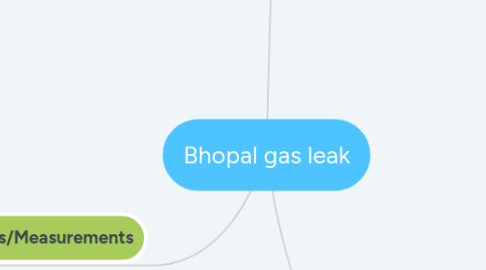
1. Units/Measurements
1.1. Weight (tons)
1.1.1. The tank contained 42 tons of methyl isocyanate which was eventually released.
1.1.2. Level indicator of the tank measured levels of liquids. It was known to be faulty and was not trusted among staff.
1.1.3. This is a crucial measurement as it caused such a massive effect on the inhabitants of Bhopal. If the amount of methyl isocyanate had been smaller the effects would have not been as great or as lethal. If it had been more then 42 tons it's possible it could have reached other cities and the casualties would have been higher.
1.2. Pressure (Pascal)
1.2.1. The pressure within the tank caused by the gases reaction to water, was built to the extent that it burst and was released into the air. No pressure would have resulted in a more controlled environment.
1.2.2. The pressure reader within the manufacturing plant was not known to be accurate so it when it read at a its max of 55psi it was not taken seriously. This reading having a history of inaccuracies in its measurements caused the leak to escape the handles of the staff.
1.2.3. If staff had known earlier there was a dangerous issue they may have alarmed the residence earlier and had better control over the situation. Staff may have had the time to call for professional help from the government and assistance from union carbide.
1.3. Concentration (Parts per million)
1.3.1. Methyl Isocyanate varied in the Bhopal area from 0.12 psi-80psi. The lethal amount of methyl Isocyanate is 21 ppm in the gas form. Bhopal incident had concentrations well beyond that amount.
1.3.2. The concentration varies because the amount of molecules of methyl isocyanate present isn't the same in all areas of the region. There are no bonds holding molecules or atoms to each other. As the substance is a gas it is free to move around and collide with each other causing the particles to move in no particular ordered fashion. It is also possible temperature, volume and pressure influenced the concentration. As temperature increases, pressure increases at a constant volume. Higher pressure leads to a a higher concentration.
2. Environment
2.1. AIr
2.1.1. Packages of various types of chemicals have been left out causing the air surrounding the factory to be toxic and most likely any humans to travel in that region will have the air-born chemicals absorbed into their skin through the moisture that's resting on it, making residents sicker. Union carbide and the government has made no move to clean up the site.
2.1.2. The air is toxic in the remains of the Bhopal factory as there has been no clean up.
2.1.3. Lake near the plant is full of poisonous metals and chemicals. Some locals bath and play in that lake because of a lack of resources. However it is the governments responsibility to clean up the site so this disaster does not continue to have lingering affects on the community
2.2. Water
2.2.1. The groundwater is poisoned with multiple metals and even carcinogens such as carbon tetra fluoride.
2.2.2. Nearby communities have been poisoned because of the groundwater as it has infected their drinking water.
3. Prevention
3.1. Future
3.1.1. Staff should not be reduced simply because the factory is not successful. Cutting staff causes less supervision over all parts of the factory and therefore increases safety risks. Staff number should correspond to factory size and amount of chemicals being held there so that the factory can run safely.
3.1.2. Reliable equipment should be used in the future so staff can make well though out decisions based on varying circumstances
3.1.3. Safety meetings should be held more often. The Union Carbide factory in Bhopal made the mistake of not holding them often enough. This results in sloppy work as demonstrated with their failure to close the pipe to the methyl isocyanate tank before cleaning it with water. Therefore it puts the lives of workers at risk as well as the surrounding community.
3.2. Alternatives
3.2.1. There is a safer chemical that has come to the market called Crystalline that should make it safer for the staff working in this environment and civilians outside.
3.2.2. Developed by Canadian chemists but wont reach the same amount of distribution of Methyl isocyanate on the international level.
3.3. After Bhopal Leak
3.3.1. Residents received around twenty-five thousand rupees which is only four hundred dollars each.
3.3.2. Compensations and support for the government has been giving but they are not living up to their promises.
3.3.3. They promised Three billion dollars in compensation but only gave 400,000.

